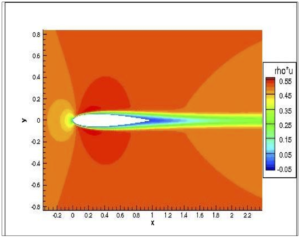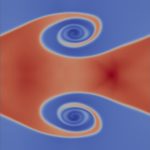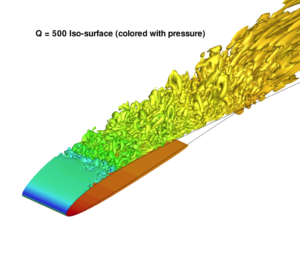About me
I am a Professor of Applied and Computational Mathematics at the University of Bergen. Most of my research is, one way or another, connected to compressible flows and aerodynamics governed by the Euler and Navier-Stokes equations. (Curriculum Vitae)
Numerical analysis

A mathematical model that aspires to predict future events has to be well-posed. That is, a solution to the model must exist; it must be unique and stable to perturbations.
Hence, well-posedness of time-dependent Partial Differential Equations (PDEs) is a recurring theme of my research. For linear PDEs, the energy method is used to derive an a priori bound on the solution and to deduce boundary conditions. From these results, well-posedness can often be established. The analysis is then mimicked for a semi-discrete numerical approximation scheme satisfying a Summation-by-parts (SBP) property and the boundary conditions are then enforced by e.g. Simultaneous Approximation Terms (SAT). In this way, stable high-order accurate schemes can be designed.
Another key question is the convergence rate of SBP-SAT schemes. The order of accuracy is easily derived for finite difference schemes, but it drops near boundaries for high-order schemes. However, the actual convergence rate is often higher than the worst case scenario and the question is: What are the weakest conditions for an improved convergence rate? Recent results suggest that energy stable schemes often have optimal convergence rates.
(The work on linear PDEs is not limited to aerodynamics but generally applicable to a large class of linear time-dependent PDEs.)
Numerical analysis of non-linear conservation laws
The overarching goals are the same as for linear PDEs. However, the mathematical theory is much less developed and well-posedness is largely unknown. This complicates the development of numerical schemes. One way to obtain some a priori

bounds is to enforce entropy stability on the scheme. (A kind generalization of the energy stability in the linear case.) My work on such schemes has been aimed towards: extending them to high-order of accuracy; including boundary conditions in the entropy stability framework; enforce both entropy stability as well as additional bounds. The long term goal is to have a scheme that satisfies strong enough bounds to allow convergence to weak solutions.
Compressible flow models
20+ years of research on the Navier-Stokes equations has led me to question the model. (See dedicated page.)
High performance computing
To demonstrate the efficacy of the schemes it is necessary to run simulations of realistic problems. Such problems invariably requires large-scale computing facilities. Hence, the schemes are coded (in F90 and MPI, or Julia) and run on parallel computers.

